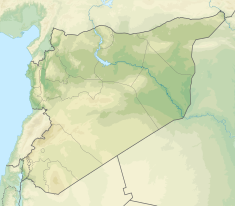
Back سد الطبقة Arabic سد الطبقه ARZ Sadd al Furāt CEB Tabqa-Talsperre German Presa de Tabqa Spanish سد طبقه Persian Barrage de Tabqa French סכר טבקה HE Էտ-Տաբկա Armenian Եփրատ ամբարտակ HYW
| Tabqa Dam | |
|---|---|
 Tabqa Dam | |
| Official name | سَدُّ الثَّوْرَةِ |
| Country | Syria, controlled by Syrian Democratic Forces |
| Location | Al-Thawrah District, Raqqa Governorate, Syria |
| Coordinates | 35°52′20″N 38°34′00″E / 35.87222°N 38.56667°E |
| Status | Operational |
| Construction began | 1968 |
| Opening date | 1973 |
| Construction cost | US$340 million |
| Dam and spillways | |
| Type of dam | Earth-fill dam |
| Impounds | Euphrates |
| Height | 60 m (197 ft) |
| Length | 4,500 m (14,764 ft) |
| Width (crest) | 19 m (62 ft) |
| Width (base) | 512 m (1,680 ft) |
| Reservoir | |
| Creates | Lake Assad |
| Inactive capacity | 11.7 km3 (2.8 cu mi) |
| Surface area | 610 km2 (236 sq mi) |
| Power Station | |
| Commission date | July 1973–8 March 1978 |
| Turbines | 8 x 103 MW Kaplan-type |
| Installed capacity | 824 MW |
The Tabqa Dam (Arabic: سَدُّ الطَّبْقَةِ, romanized: Sadd aṭ-Ṭabqah, Kurdish: Bendava Tebqa; Classical Syriac: ܣܟܪܐ ܕܛܒܩܗ, romanized: Sekro d'Tabqa), or al-Thawra Dam as it is also named (Arabic: سَدُّ الثَّوْرَةِ, romanized: Sadd aṯ-Ṯawrah, Kurdish: Bendava Tewra; Classical Syriac: ܣܟܪܐ ܕܬܘܪܗ, romanized: Sekro d'Ṯawra, literally "Revolution Dam"), most commonly known as Euphrates Dam (Arabic: سَدُّ الْفُرَاتِ, romanized: Sadd al-Furāt; Kurdish: Bendava Firatê; Classical Syriac: ܣܟܪܐ ܕܦܪܬ, romanized: Sekro d'Frot), is an earthen dam on the Euphrates, located 40 kilometres (25 mi) upstream from the city of Raqqa in Raqqa Governorate, Syria. The city of Al-Thawrah is located immediately south of the dam. The dam is 60 metres (200 ft) high and 4.5 kilometres (2.8 mi) long and is the largest dam in Syria.[1] Its construction led to the creation of Lake Assad, Syria's largest water reservoir. The dam was constructed between 1968 and 1973 with help from the Soviet Union. At the same time, an international effort was made to excavate and document as many archaeological remains as possible in the area of the future lake before they would be flooded by the rising water. When the flow of the Euphrates was reduced in 1974 to fill the lake behind the dam, a dispute broke out between Syria and Iraq (which is downstream) that was settled by intervention from Saudi Arabia and the Soviet Union.[2] The dam was originally built to generate hydroelectric power, as well as irrigate lands on both sides of the Euphrates. The dam has not reached its full potential in either of these objectives.[3]
